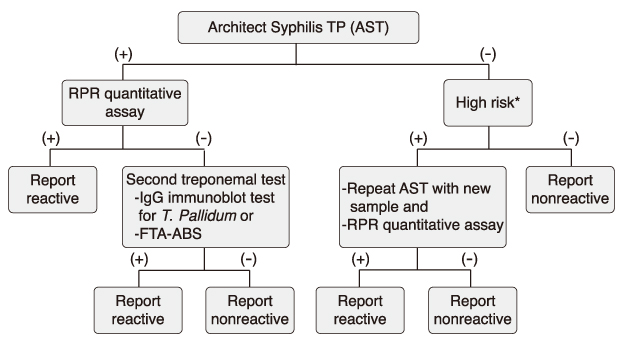J Korean Med Assoc.
2009 Nov;52(11):1100-1106. 10.5124/jkma.2009.52.11.1100.
Recent Trends in Clinical Observation of Syphilis and Consideration for Laboratory Tests
- Affiliations
-
- 1Department of Dermatology, Chosun University College of Medicine, Korea. kcchoi@chosun.ac.kr
- KMID: 2188092
- DOI: http://doi.org/10.5124/jkma.2009.52.11.1100
Abstract
- Syphilis is an infectious and sexually transmitted chronic disease caused by Treponema pallidum. The progression of syphilis is classified into early symptomatic (primary, secondary, early latent) and late asymptomatic (late latent, tertiary) stage. Since the late 20th century, resurgence of infectious syphilis have been occuring among hetero- and homosexual males with HIV co-infection over the world, and similar trend can also be observed in Korea. In order to contain the current spread of syphilis, clinical presentation and diagnostic approach must first become available, and in particular, the peculiarity in HIV co-infection should also be considered. Serology remains the mainstay of laboratory testing for syphilis, except for during the very early stage of infection. If syphilis patients are not diagnosed properly, it may lead to a serious public health problem. Based on the review of literatures, RPR/VDRL test is not reliable as a single screening test, and a new syphilis test algorithm of treponemal antibody test needs to be established as a primary screening test.
Keyword
MeSH Terms
Figure
Cited by 3 articles
-
Establishment and Multicenter Evaluation of a National Reference Panel for Syphilis Antibodies in Korea
Hee Jin Huh, Seok Lae Chae, Deok-Ja Oh, Quehn Park, Chae Seung Lim, Tae Hyun Um, Yun Mi Park, Young Joo Cha
Lab Med Online. 2014;4(1):36-42. doi: 10.3343/lmo.2014.4.1.36.Evaluation of Centaur Syphilis, Immulite Syphilis, and Mediace TPLA for Detecting Treponemal Antibodies
Dong Hee Seo, Dong Hee Whang, Shin Young Joo, Hyen Hee Choi
Lab Med Online. 2015;5(2):77-83. doi: 10.3343/lmo.2015.5.2.77.A Case of Rectal Syphilis Incidentally Found at Regular Medical Check-up
Ji Hong You, Ki Won Cho, Yoon Jin Cha, Hyo Jin Park
Korean J Gastroenterol. 2016;68(4):218-220. doi: 10.4166/kjg.2016.68.4.218.
Reference
-
1. Sanchez MR. Wolff K, Goldsmith LA, Katz SI, Gilchrest BA, Paller AS, Leffell DJ, editors. Syphilis. Fitzpatrick's dermatology in general medicine. 2008. 7th ed. New york: McGraw-Hill;1955–1977.2. Willcox RR. A World wide view of venereal disease. Br J Vener Dis. 1972. 48:163–176.3. Chen Z, Zhang G, Gong X. Syphilis returns to China: results of the national surveillance program from the Chinese Center for STD Control, Nanjing, China. Lancet. 2007. 369:132–138.4. Lautenschlager S. Diagnosis of Syphilis: Clinical and laboratory problems. J Dtsch Dermatol Ges. 2006. 12:1058–1072.
Article5. Nicoll A, Harmers FE. Are trends in HIV, gonorrhea, and syphilis worsening in Western Europe? BMG. 2002. 324:1324–1327.6. Lin CC, Gao X, Chen XS, Chen Q, Cohen MS. China's Syphilis Epidemic: A Systemic Review of Seroprevalence Studies. Sex Transm Dis. 2006. 33:726–736.7. Chun IK, Shon HS, Kim YP. Clinical Observation of Syphilis during Ten Consecutive Years (1968~1977). Korean J Dermatol. 1979. 17:17–27.8. Goh BT. Syphilis in adults. Sex Transm Infect. 2005. 81:448–452.
Article9. Comparison of early and late latent syphilis-Colorado, 1991. MMWR Morb Mortal Wkly Rep. 1993. 42:155–157.10. Lynn WA, Lightman S. Syphilis and HIV: a dangerous combination. Lancet Infect Dis. 2004. 4:456–466.
Article11. Zetola NM, Klausner JD. Syphilis and HIV infection: an update. Clin Infect Dis. 2007. 44:1222–1228.
Article12. Kim HS, Lee HS, Lee MG, Lee JB. Recent Trends of Syphilis Prevalence in the Normal Population in Korea - 1995. Korean J Dermatol. 1997. 35:514–519.13. Choi YS, Yu HJ, Son SJ. Prevalence of Syphilis in Normal Population in Korea (1987-1991). Korean J Dermatol. 1994. 32:866–871.14. Shin BS, Song JY, Chung BS, Choi KC. A clinical study of case of syphilis referred to our dermatologic clinic(2002~2007). Korean J Dermatol. 2008. 46:1179–1185.15. Park HJ. Clinical observation and statistical consideration of syphilis(2000-2007). Korean J Dermatol. 2008. 46:1344–1352.16. Korea Centers for Disease Control and Prevention. Disease web statistics system. 2003~2008.17. Lee SH, Suh DH, Cho KH, Eun HC. Two cases of unusual man-ifestations of secondary syphilis accompanied by human immunodeficiency virus infection. Korean J Dermatol. 2004. 41:354–359.18. Kang SK, Kim ES, Lee MW, Choi JH, Sung KJ, Moon KC. Two cases of secondary syphilis accompanied by acquired immunodeficiency syndrome. Korean J Dermatol. 2002. 40:428–432.19. French P, Gomberg M, Janier M, Schmidt B, van Voorst Vader P, Young H. IUSTI: 2008 European Guidelines on the Management of Syphilis. Int J STD AIDS. 2009. 20:300–309.
Article20. Kingston M, French P, Goh B, Goold P, Higgins S, Sukthankar A, Stott C, Turner A, Tyler C, Young H. UK National Guidelines on the Management of Syphilis 2008. Int J STD AIDS. 2008. 19:729–740.
Article21. Kim JY, Kim WH, Cho CH, Kim GY, Nam MH, Kim JS, Bae SY, Cho YJ. Evaluation of automated architect syphilis TP as a diagnostic laboratory screening test for syphilis. Korean J Lab Med. 2008. 28:475–482.
Article22. Huh HJ, Lee KK, Kim ES, Chae SL. Analysis of positive result in mediace rapid plasma reagin and treponema pallidum latex agglutinination as the automated syphilis test. Korean J Lab Med. 2007. 27:324–329.
Article23. Harris JRW. The control of venereal disease. Brit J Vener Dis. 1975. 51:285–288.
Article


